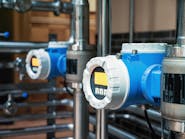Quiz Corner: Calculating flow error for pressure transmitter installation and calibration
An orifice plate is sized to produce a differential pressure of 0 to 100 inches of water column (WC) corresponding to zero to full-scale flow respectively through a nominal 200# steam header where the flowmeter is located approximately 25 feet above grade. A pressure transmitter calibrated for 0 to 300 psig will be installed and used to pressure compensate the flow measurement. The pressure and differential pressure transmitters will be mounted on pipe stands for convenient access. What is the approximate flow error associated with the pressure transmitter installation and calibration?
- 5% high
- 2.5% high
- No error
- 2.5% low
- 5 % low
The steam header is located approximately 25 feet above grade. Transmitters are typically mounted approximately 4.5 feet above grade. Therefore, the pressure transmitter calibration will introduce an error in the amount of its condensate leg of approximately 20 feet, or approximately 10 psi where 2 feet of water column roughly corresponds to 1 psi.
The pressure transmitter will measure high by approximately 5% (10/200) but slightly less so when considered in absolute pressure terms (10/215). The output of differential pressure flowmeters changes by approximately -0.5% per percent density change where increasing pressure increases density. In this application, the measured pressure is higher than the actual header pressure so the differential pressure flowmeter will tend to measure lower than the actual flow by approximately 2.5% (Answer D).
Additional complicating factors
The density of the condensate is dependent on its temperature, which is usually assumed to be uniform along the length of the condensate leg. However, the temperature of the condensate (and thereby its density) can vary with the seasons in outdoor locations in some applications. In other applications, the condensate temperature can be significantly different in different parts of the condensate leg such as when the differential pressure transmitter is located outdoors, and the pressure transmitter is located indoors.
David W. Spitzer has written over 500 technical articles and 10 books on flow measurement, instrumentation, process control and variable speed drives. David offers consulting services, writes/edits white papers, presents seminars and provides expert witness services at Spitzer and Boyes LLC (spitzerandboyes.com or +1.845.623.1830).
David W. Spitzer
David W Spitzer’s new book Global Climate Change: A Clear Explanation and Pathway to Mitigation (Amazon.com) adds to his over 500 technical articles and 10 books on flow measurement, instrumentation, process control and variable speed drives. David offers consulting services and keynote speeches, writes/edits white papers, presents seminars, and provides expert witness services at Spitzer and Boyes LLC (spitzerandboyes.com or +1.845.623.1830).


